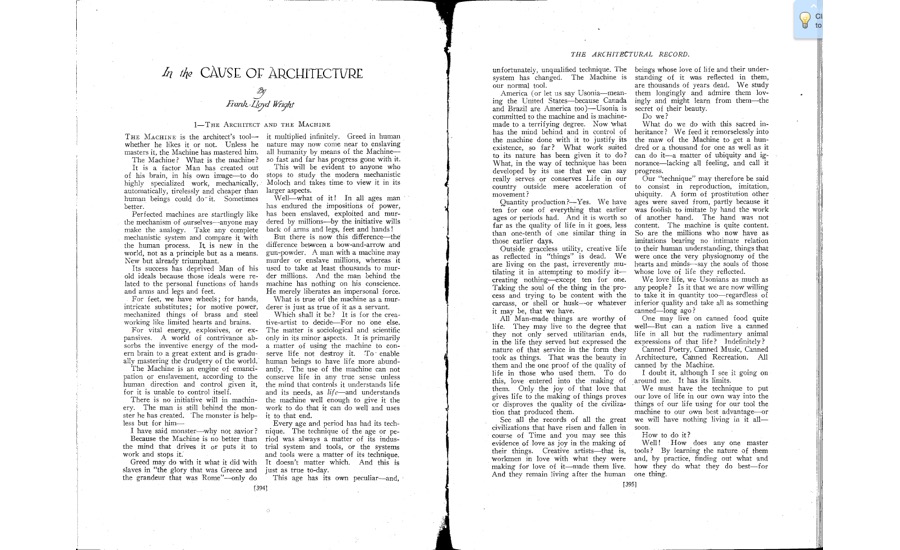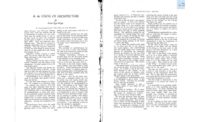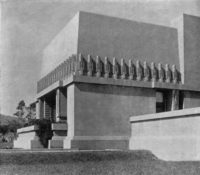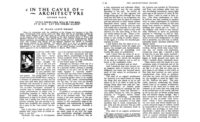From Architectural Record, May, 1927. Read a PDF of the original article here.
The Machine is the architect’s tool – whether he likes it or not. Unless he masters it, the Machine has mastered him.
The Machine? What is the machine?
It is a factor Man has created out of his brain, in his own image – to do highly specialized work, mechanically, automatically, tirelessly and cheaper than human beings could do it. Sometimes better.
Perfected machines are startlingly like the mechanism of ourselves – anyone may make the analogy. Take any complete mechanistic system and compare it with the human process. It is new in the world, not as a principle but as a means. New but already triumphant.
Its success has deprived Man of his old ideals because those ideals were related to the personal functions of hands and arms and legs and feet.
For feet, we have wheels; for hands, intricate substitute; for motive power, mechanized things of brass and steel working like limited hearts and brains.
For vital energy, explosives, or expansive. A world of contrivance absorbs the inventive energy of a modern brain to a great extent and its gradually mastering the drudgery of the world.
The Machine is an engine of emancipation or enslavement, according to the human direction and control given it, for it is unable to control itself.
There is no initiative will in machinery. The man is still behind the monster he has created. The monster is helpless but for him –
I have said monster – why not savoir?
Because the Machine is no better than the mind that drives it or puts it to work and stops it.
Greed may do with it what it did with slaves in “the glory that was Greece and the grandeur that was Rome” – only do it multiplied indefinitely. Greed in human nature may now come near to enslaving all humanity by means of the Machine – so fast and far has progress gone with it.
This will be evident to anyone who stops to study the modern mechanistic Moloch and takes time to view it in its larger aspect.
Well – what of it! In all ages man has endured the impositions of power, has been enslaved, exploited and murdered by millions – by the initiative wills back of arms and legs, feet and hands!
But there is now this difference – the difference between a bow-and-arrow and gun-powder. A man with a machine may murder or enslave millions, whereas it used to take at least thousands to murder millions. And the man behind the machine has nothing on his conscience. He merely liberates an impersonal force.
What is true of the machine as a murderer is just as true of it as a servant.
Which shall it be? It is for the creative-artist to decide –For no one else. The matter is sociological and scientific only in its minor aspects. It is primarily a matter of using the machine to conserve life not destroy it. To enable human beings to have life more abundantly. The use of the machine can not conserve life I n any true sense unless the mind that controls it understands life and its needs, as life and understands the machine well enough to give it the work to do that it can do well and uses it to that end.
Every age and period has had its technique. The technique of the age or period was always a matter of its industrial system and tools, or the systems and tools were a matter of its technique. It doesn’t matter which. And this is true to-day.
This age has its own peculiar – and, unfortunately, unqualified technique. The system has changed. The Machine is our normal tool.
America (or let us say Usonia – meaning the United States – because Canada and Brazil are America too) – Usonia is committed to the machine and it machine-made to a terrifying degree. Now what has the mind behind and in control of the machine done with it to justify its existence, so far? What work suited to its nature has been given it to do? What, in the way of technique has been developed by its use that we can say really serves or conserves Life in our country outside mere acceleration of movement?
Quantity production? – Yes. We have ten for one of everything that earlier ages or periods had. And it is worth so far as the quality of life in it goes, less than one-tenth of one similar thing in those earlier days.
Outside graceless utility, creative life as reflected in “things” is dead. We are living on the past, irreverently mutilating it in attempting to modify it – creating nothing – except ten for one. Taking the soul of the thing in the process and trying to be content with the carcass, or shell or husk – or whatever it may be, that we have.
All Man-made things are worthy of life. They may live to the degree that they not only served utilitarian ends, in the life they served but expressed the nature of that service in the form they took at things. That was the beauty in them and the one proof of the quality of life in those who used them. To do this, love entered into the making of them. Only the joy of that love that gives life to the making of things proves or disproves the quality of the civilization that produced them.
See all the records of all the great civilizations that have risen and fallen in the course of Time and you may see this evidence of love as joy in the making of their things. Creative artists – that is, workmen in love with what they were making for love of it – made them live. And they remain living after the human beings whose love of life and their understanding of it was reflected in them, are thousands of years dead. We study them longingly and admire them lovingly and might learn from them – the secret of their beauty.
Do we?







